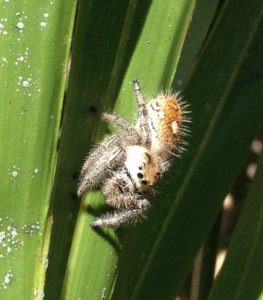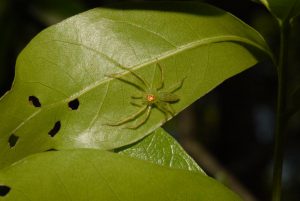Do spiders make you jump? Meet the spiders that YOU might make jump! The largest family of spiders in the world are the Salticidae, which means “jumpers” in Latin. Here in Pinellas we have a great diversity of these charming little arachnids, some with very impressive coloration.
About Jumping Spiders
Jumping spiders are recognizable by their large forward-facing eyes. This enables these hunters to spot their prey and quickly attack. Jumping spiders also have four more eyes arranged in two rows behind the larger eyes. This helps in detecting prey/danger from many directions. Jumping spiders do not use their silk to spin webs, but rather for anchoring to a jumping-off spot or for wrapping egg cases.
A few common jumping spiders that may be found around the house or in our parks and preserves are:
Regal Jumping Spider (Phippidus regius)

A large and colorful species, males are black and white with green iridescent chelicerae (the mouthparts that the fangs are attached to). The male can flash these chelicerae to attract/impress a potential mate. Females are bright orange and tan. These are the largest of the jumping spiders in our area.
Twinflagged Jumping Spider (Anasaitis canosa)
![By Photographed by G. B. Edwards [CC BY 3.0 (http://creativecommons.org/licenses/by/3.0)], via Wikimedia Commons](https://blogs.ifas.ufl.edu/pinellasco/files/2017/11/Edwards_Anasaitis_canosa_01.jpg)
Magnolia Green Jumping Spider (Lyssomanes viridis)

Can be found around evergreen trees like Live Oak (Quercus virginiana) and Southern Magnolia (Magnolia grandiflora). This jumper is distinguished by its pale, translucent green color. Males have large, impressive jaws. Both sexes have a red spot on the top of their head.
Jumping spiders are fascinating to watch, especially since they seem to watch you back! They are completely harmless and provide much-needed ecosystem services; keeping potentially harmful insect populations in check.
References: Common Florida Spiders – http://edis.ifas.ufl.edu/in017 and Florida’s Fabulous Spiders, World Publications, 2002
This blog was written by Extension Specialist, James Stevenson. Edited by Lara Milligan.
 2
2
